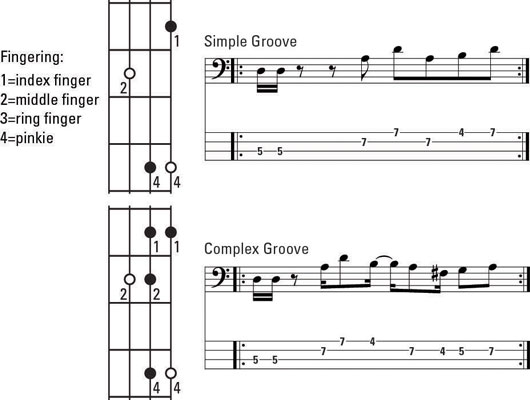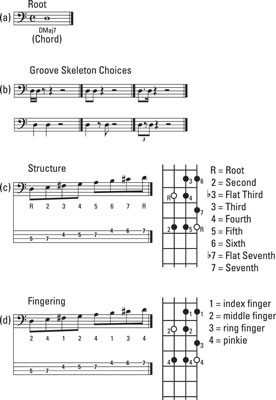Say you’re jamming away with the band as a bass guitarist on a minor groove, when all of a sudden the guy in charge yells (with uninhibited enthusiasm), “Let’s jam in D major!” Hmmm, does he really mean major? Here’s the way to respond to that enthusiasm.
Determine the root of the chord.
In this case, the chord is D major (D Maj or D Maj7), so the root of the chord is D.
Decide what kind of groove skeleton you want to play.
Choose from the basic choices.
Choose the appropriate scale for the chord.

For the D major chord in this example, the proper scale is D Ionian.
To play the D Ionian scale, you start the scale on the 5th fret of the A string and end it on the 7th fret of the G string. Choose the notes for your groove from this scale. You can pick the choice notes from the intervals marked.
Position your left hand.
You want to avoid any unnecessary shifting with your left hand. So start the D Ionian scale with the middle finger of your left hand on the D (5th fret of the A string), which is the root. You can reach all the notes of the scale from this position without moving your left hand.
Decide how mobile your groove needs to be.

If the tune has different chords — if the roots change — your groove has to be mobile (moveable from chord to chord), so the groove you create needs to be a simple one. Use only a few notes and make them easy to play.
If you stay on one chord for a while, you can make your groove a bit more complex to keep it interesting. You can see both a simple and a complex version of the same groove.
In the case of the major chord, you have to consider one more thing when choosing the notes for the groove: The 7 of the Ionian scale doesn’t sound all that great in a groove format, so avoid it if you can. Choose the 6 instead; the 6 is usually a great choice, but let your own ears decide what’s right.
Check out the steps necessary for creating a major groove. First, the D major chord is played on the keyboard, with the bass adding the root. Next, different groove skeletons are played on the root of the chord. Then you hear the sound of the Ionian mode, the correct scale for D major.
Finally, listen to a simple groove in D major, followed by a complex groove in D major. Notice how the 6 of the mode is played in the groove rather than the 7.

